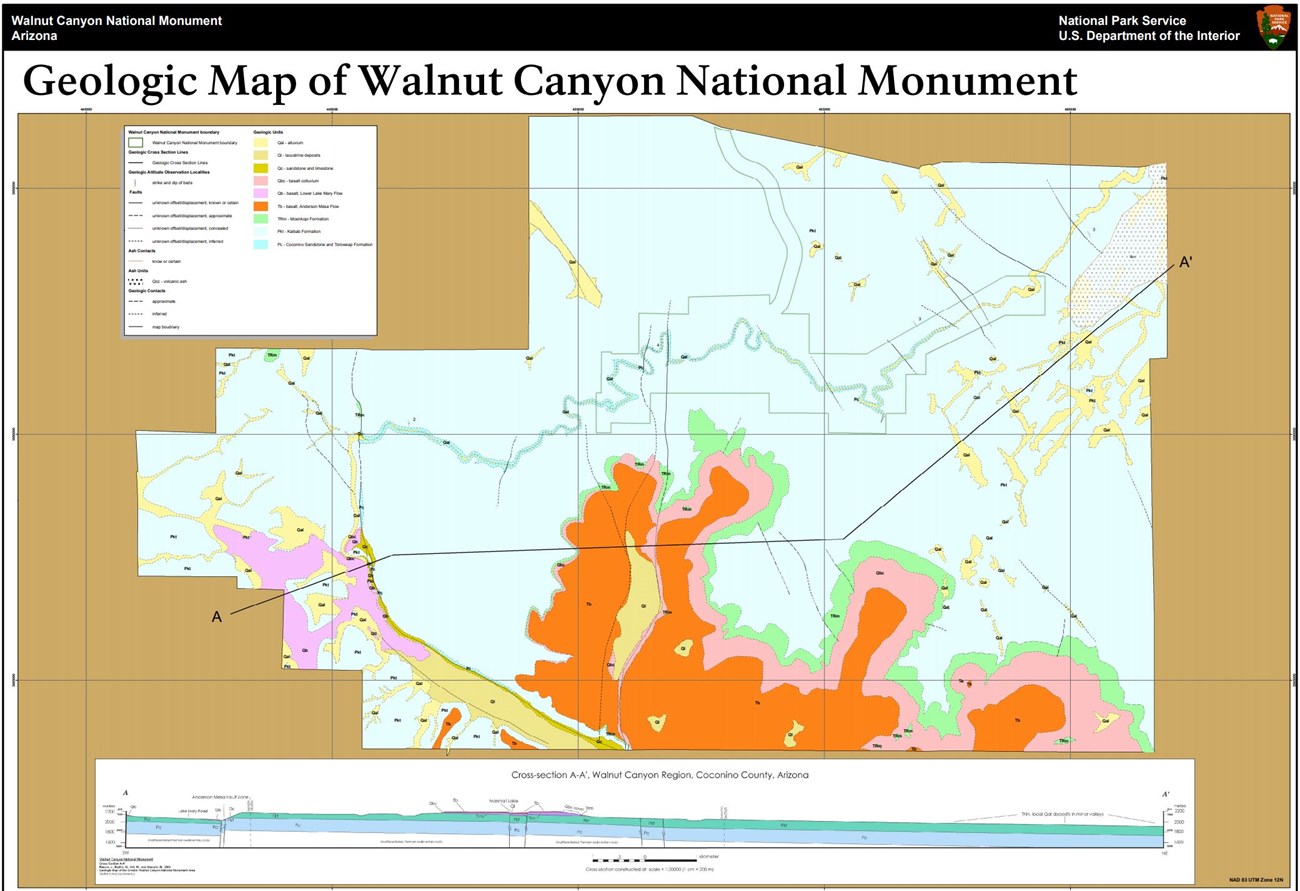Last updated: July 17, 2024
Article
NPS Geodiversity Atlas—Walnut Canyon National Monument, Arizona
Geodiversity refers to the full variety of natural geologic (rocks, minerals, sediments, fossils, landforms, and physical processes) and soil resources and processes that occur in the park. A product of the Geologic Resources Inventory, the NPS Geodiversity Atlas delivers information in support of education, Geoconservation, and integrated management of living (biotic) and non-living (abiotic) components of the ecosystem.

Introduction
Walnut Canyon National Monument is located just 16 km (10 mi) from downtown Flagstaff in Coconino County, Arizona. Authorized on November 30, 1915, Walnut Canyon encompasses nearly 1,428 hectares (3,529 acres) and protects a high concentration of well-preserved Northern Sinagua cliff dwellings, pit houses, and other cultural resources situated in deeply incised canyon topography. Cliff dwellings in WACA are located in the upper third of Walnut Canyon, named after the Arizona walnut trees that grow along the floor of the canyon (Graham 2008). The Northern Sinagua people constructed the cliff dwellings and pit houses about 800 years ago in shallow alcoves of relatively soft sandstone nestled under harder, more resistant ledges of limestone. The cliff dwellings and rich biological communities in WACA hold traditional cultural importance for numerous American Indian tribes in the American Southwest.
Geologic Setting
The geology of Walnut Canyon National Monument is predominantly controlled by Walnut Canyon and the entrenched segment of Walnut Creek that has incised into relatively horizontal layers of Paleozoic limestone and sandstone. Walnut Canyon averages 402 m (1,320 ft) wide from rim-to-rim and reaches a maximum depth of 122 m (400 ft) at the western (upstream) boundary (Graham 2008). Incision of the canyon has revealed resistant gray limestone of the Permian Kaibab Formation in the upper walls and rim, with light tan, cross-bedded sandstone exposures of the Toroweap Formation and Coconino Sandstone underneath (Figure 135; Graham 2008). Sandstones such as the Coconino Sandstone not only served as protective alcove shelters for the Northern Sinagua but represent an important regional aquifer.
Regional Geology
Walnut Canyon National Monument is a part of the Colorado Plateaus Physiographic Province and shares its geologic history and some characteristic geologic formations with a region that extends well beyond park boundaries.
- Scoping summaries are records of scoping meetings where NPS staff and local geologists determined the park’s geologic mapping plan and what content should be included in the report.
- Digital geologic maps include files for viewing in GIS software, a guide to using the data, and a document with ancillary map information. Newer products also include data viewable in Google Earth and online map services.
- Reports use the maps to discuss the park’s setting and significance, notable geologic features and processes, geologic resource management issues, and geologic history.
- Posters are a static view of the GIS data in PDF format. Newer posters include aerial imagery or shaded relief and other park information. They are also included with the reports.
- Projects list basic information about the program and all products available for a park.
Source: NPS DataStore Saved Search 3192. To search for additional information, visit the NPS DataStore.
A NPS Soil Resources Inventory project has been completed for Walnut Canyon National Monument and can be found on the NPS Data Store.
Source: NPS DataStore Saved Search 3217. To search for additional information, visit the NPS DataStore.

Related Links
Related Articles
Walnut Canyon National MonumentNational Park Service Geodiversity Atlas
The servicewide Geodiversity Atlas provides information on geoheritage and geodiversity resources and values within the National Park System. This information supports science-based geoconservation and interpretation in the NPS, as well as STEM education in schools, museums, and field camps. The NPS Geologic Resources Division and many parks work with National and International geoconservation communities to ensure that NPS abiotic resources are managed using the highest standards and best practices available.

